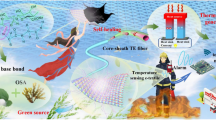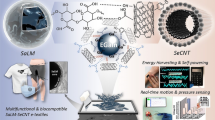Abstract
The article describes synthesis and sensing properties of SnO2–Co3O4 spheres composed of aggregated nanoparticles. Co3O4 was doped with pristine SnO2, and the resulting nanocomposite spheres were incorporated into a silicon adhesive. This material is shown to enable impedimetric sensing of relative humidity (RH). The impedance of the material decreases by 80% at a 1.0 kHz working frequency and by a factor of 2500 at 100 Hz. Capacitance increases by 70% at 1.0 kHz frequency and by a factor of 1509 at 100 Hz. The sensor works in the 10–90% RH range at temperatures from 10 to 80 °C. SnO2–Co3O4 based humidity sensor exhibited high sensitivity which makes it suitable material for the utilization in humidity meter.






Similar content being viewed by others
References
S.B. Khan, S.A. Khan, A.M. Asiri, A fascinating combination of Co, Ni and Al nanomaterial for oxygen evolution reaction. Appl. Surf. Sci. 370, 445 (2016)
S.A.B. Asif, S.B. Khan, A.M. Asiri, Efficient solar photocatalyst based on cobalt oxide/iron oxide composite nanofibers for the detoxification of organic pollutants. Nanoscale Res. Lett. 9, 510 (2014)
S.A. Khan, S.B. Khan, A.M. Asiri, Core–shell cobalt oxide mesoporous silica based efficient electro-catalyst for oxygen evolution. New J. Chem. 39, 5561 (2015)
S.A. Khan, S.B. Khan, A.M. Asiri, Electro-catalyst based on cerium doped cobalt oxide for oxygen evolution reaction in electrochemical water splitting. J. Mater. Sci.: Mater. Electron. 27, 5294 (2016)
M.T.S. Chani, S.B. Khan, K.S. Karimov, A.M. Asiri, K. Akhtar, M.N. Arshad, Synthesis and pressure sensing properties of the pristine cobalt oxide nanopowder. Int. J. Electrochem. Sci. 10, 10433 (2015)
M.M. Rahman, A. Jamal, S.B. Khan, M. Faisal, Highly sensitive ethanol chemical sensor based on Ni-doped SnO2 nanostructure materials. Biosens. Bioelectron. 28, 127 (2011)
M.V. Fuke, P. Kanitkar, M. Kulkarni, B.B. Kale, R.C. Aiyer, Effect of particle size variation of Ag nanoparticles in Polyaniline composite on humidity sensing. Talanta 81, 320 (2010)
N. Camaioni, G.C. Micelia, Y. Li, M.J. Yang, A. Zanelli, Water activated ionic conduction in cross-linked polyelectrolytes. Sens. Actuators B 134, 230 (2008)
A.T. Ramaprasad, V. Rao, Chitin–polyaniline blend as humidity sensor. Sens. Actuators B 148, 117 (2010)
S.K. Shukla, S.K. Shukla, P.P. Govender, E.S. Agorku, A resistive type humidity sensor based on crystalline tin oxide nanoparticles encapsulated in polyaniline matrix. Microchim. Acta 183, 573 (2016)
R. Nohria, R.K. Khillan, Y. Su, R. Dikshit, Y. Lvov, K. Varahramyan, Humidity sensor based on ultrathin polyaniline film deposited using layer-by-layer nanoassembly. Sens. Actuators B 114, 218 (2006)
J.R. Huang, M.Q. Li, Z.Y. Huang, J.H. Liu, A novel conductive humidity sensor based on field ionization from carbon nanotubes. Sens. Actuators A 133, 467 (2007)
N. Horzum, D. Taşçıoglu, S. Okur, M.M. Demir, Humidity sensing properties of ZnO-based fibers by electrospinning. Talanta 85(2011), 1105–1111 (2011)
H. Lam, G. Rao, J. Loureiro, L. Tolosa, Dual optical sensor for oxygen and temperature based on the combination of time domain and frequency domain techniques. Talanta 84(2011), 65–70 (2011)
S. Park, J. Kang, J. Park, S. Mun, One-bodied humidity and temperature sensor having advanced linearity at low and high relative humidity range. Sensor Actuator. B Chem. 76(2001), 322–326 (2001)
J. Huang, Y. Hao, H. Lin, D. Zhang, J. Song, D. Zhou, Mater. Sci. Eng. B 99, 523 (2003)
S.B. Khan, K.S. Karimov, M.T.S. Chani, A.M. Asiri, K. Akhtar, N. Fatima, Impedimetric sensing of humidity and temperature using CeO2–Co3O4 nanoparticles in polymer hosts. Microchim. Acta 182, 2019 (2015)
M.T. Saeed, K.S. Karimov, S.B. Khan, A.M. Asiri, Fabrication and investigation of cellulose acetate-copper oxide nano-composite based humidity sensors. Sens. Actuators A (2016). doi:10.1016/j.sna.2016.05.016
M.T.S. Chani, A.M. Asiri, K.S. Karimov, M. Bashir, S.B. Khan, M.M. Rahman, Carbon nanotubes-silicon nanocomposites based resistive temperature sensors. Int. J. Electrochem. Sci. 10, 3784 (2015)
S.B. Khan, M.T.S. Chani, K.S. Karimov, A.M. Asiri, M. Bashir, R. Tariq, Humidity and temperature sensing properties of copper oxide–Si-adhesive nanocomposite. Talanta 120, 443 (2014)
M.T.S. Chani, K.S. Karimov, S.B. Khan, A.M. Asiri, M. Saleem, M. Bashir, Fe2O3–silicone adhesive composite based humidity sensors. Optoelectron. Adv. Mater. Rapid Commun. 7, 861 (2013)
M.T.S. Chani, A.M. Asiri, K.S. Karimov, K.N. Atif, S.B. Khan, K.A. Alamry, Aluminium phthalocyanine chloride thin films for temperature sensing. Chin. Phys. B 22, 8101 (2013)
J.W. Dally, W.F. Riley, K.G. Mc Connel, Instrumentation for engineering measurements, 2nd edn. (Wiley, New York, 1993)
Z. Chen, C. Lu, Humidity Sensors: a review of materials and mechanisms. Sens. Lett 3, 274 (2005)
M. Yang, Y. Li, X. Zhan, M. Ling, A novel resistive-type humidity sensor based on poly(p-diethynylbenzene). J. Appl. Polym. Sci. 74, 2010 (1999)
Barsan N. OpreaA, U. Weimar, M.L. Bauersfeld, D. Ebling, J. Wollenstein, Capacitive humidity sensors on flexible RFID labels. Sens. Actuators B 132, 404 (2008)
M.J. Yang, Y. Li, N. Camaioni, G. Casalbore-Miceli, A. Martelli, G. Ridolfi, Polymer electrolytes as humidity sensors: progress in improving an impedance device. Sens. Actuators B 86, 229 (2002)
Acknowledgements
The authors are grateful to the Department of Chemistry and the Center of Excellence for Advanced Materials Research (CEAMR) at King Abdulaziz University for providing research facilities.
Author information
Authors and Affiliations
Corresponding author
Rights and permissions
About this article
Cite this article
Din, A., Karimov, K.S., Akhtar, K. et al. Impedimetric humidity sensor based on the use of SnO2–Co3O4 spheres. J Mater Sci: Mater Electron 28, 4260–4266 (2017). https://doi.org/10.1007/s10854-016-6049-1
Received:
Accepted:
Published:
Issue Date:
DOI: https://doi.org/10.1007/s10854-016-6049-1




